Atrust MT188L User Manual
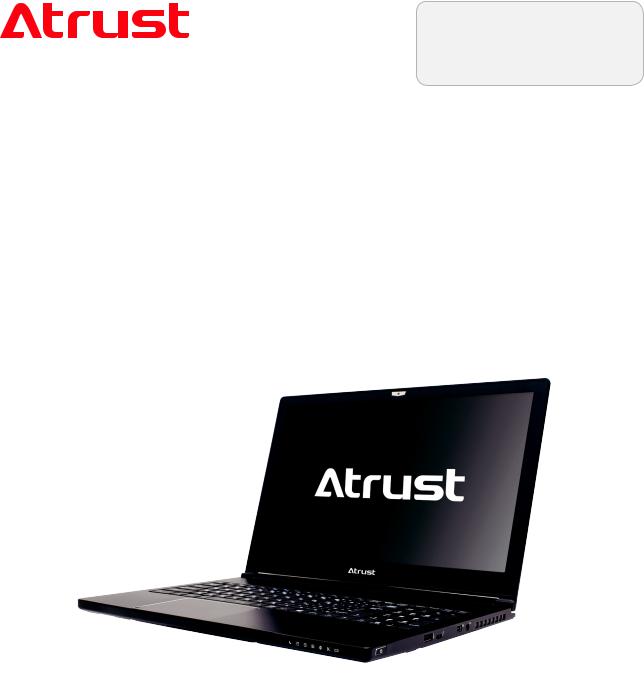
Topics Covered:
Setup and Maintenance
Basics as an Endpoint Device in VDI
Atrust Client Setup Console
Mobile Thin Client Solution
Atrust mt188L
USER’S MANUAL

Internal Draft 0.01
Copyright © 2017 Atrust Computer Corp.
UM-mt188L-EN-17122117

i
Copyright and Trademark Statements
Copyright © 2017 Atrust Computer Corp. All rights reserved.
This document contains proprietary information that is protected by copyright. No part of this document may be photocopied, reproduced, or translated to another language without the prior written consent of Atrust Computer Corp.
Disclaimer
Atrust Computer Corp. (“Atrust”) makes no representations or warranties with respect to the contents or use of this document, and specifically disclaims any express or implied warranties of merchantability or fitness for any
particular purpose. Atrust is not liable for technical or editorial errors or omissions contained herein. The information in this document is subject to change without notice.
Trademark Statements
Atrust is a trademark of Atrust Computer Corp.
Intel is a registered trademark of Intel Corporation or its subsidiaries in the United States and other countries.
Microsoft, Windows, Windows Server, RemoteFX, and MultiPoint are trademarks or registered trademarks of the Microsoft group of companies.
Citrix, ICA, XenApp, XenDesktop, and VDI-in-a-Box are trademarks of Citrix Systems, Inc. and/or one or more of its subsidiaries, and may be registered in the United States Patent and Trademark Office and in other countries.
VMware, VMware View, and VMware Horizon View are trademarks or registered trademarks of the VMware, Inc.
PCoIP is a registered trademark of Teradici Corporation in the United States and/or other countries.
Other product names mentioned herein are used for identification purposes only and may be trademarks and/or registered trademarks of their respective companies.
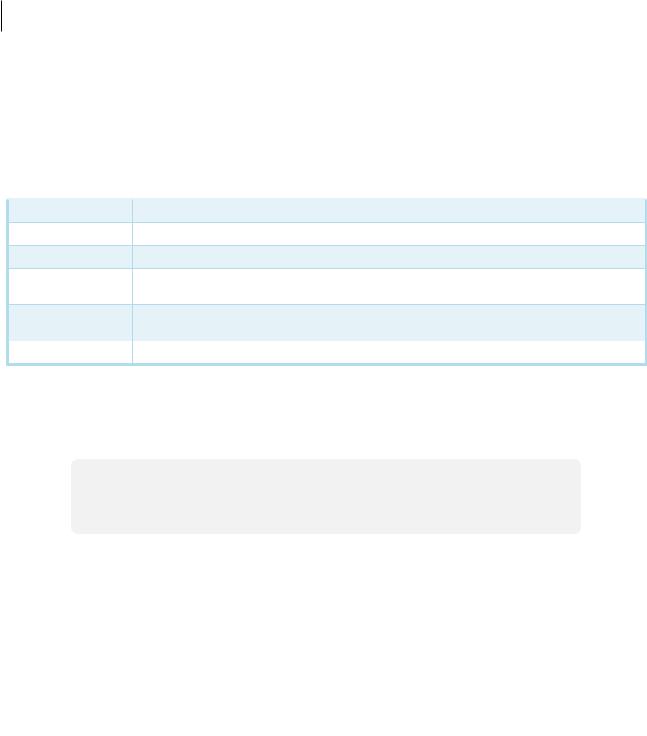
ii
About This User’s Manual
This manual provides detailed instructions on how to set up, use, and maintain Atrust mt188L mobile thin clients.
Manual Structure and Subjects
Chapter |
Subject |
|
|
1Provides an overview of Atrust mt188L mobile thin clients.
2Provides detailed instructions on how to set up Atrust mt188L mobile thin clients.
3Provides the basics of how to use Atrust mt188L mobile thin clients.
4Provides instructions on how to configure client settings and customize Atrust mt188L mobile thin clients with the Atrust Client Setup console.
Appendices |
Provides supplementary instructions on advanced settings, maintenance, and upgrade for |
|
Atrust mt188L mobile thin clients. |
||
|
||
|
|
|
Specifications |
Provides detailed information on key components of Atrust mt188L mobile thin clients. |
Notes, Tips, and Warnings
Throughout this manual, the notes, tips, and warnings in the following formats are used to provide important information, useful advice, and prevent injuries to you, damage to your devices, or loss of data on your system.
NOTE
• A note provides important information for a specific situation.
TIP
• A tip gives a piece of useful advice to perform a task more efficiently.
WARNING
• A warning provides crucial information that must be followed to prevent injuries to you, damage to your devices, or loss of data on your system.

iii
Style Conventions
The following styles are used throughout this manual while referring to operational items on input devices, hardware panels, or application interfaces.
Item |
Style |
Example |
|
|
|
|
|
keys on the keyboard |
bold |
Ctrl + F2, Alt + F9, Alt + Tab |
|
|
|
|
|
application windows or |
first letter |
Confirm Dialog window, RDP Connection list, ICA Connection list, |
|
entry lists |
capitalized |
View Connection list |
|
|
|
|
|
buttons or tabs on a |
|
OK, Next, Save, Applications tab |
|
window, toolbars, taskbar, |
bold |
||
or menu |
|
|
|
|
|
|
|
options on a window, |
bold |
Add, Domain, Connection Type, High Quality |
|
screen, list, or menu |
|||
|
|
||
|
|
|
|
|
|
Applications > Citrix ICA, Applications > Remote Desktop, |
|
selecting a series of options |
bold |
Applications > VMware View, Network > Wireless, |
|
|
|
Devices > Printer, System > Time Zone |
|
|
|
|

iv
Safety and Regulatory Information
Regulatory Statement
Federal Communications Commission Interference Statement
This equipment has been tested and found to comply with the limits for a Class B digital device, pursuant to Part 15 of the FCC Rules. These limits are designed to provide reasonable protection against harmful interference in a residential installation. This equipment generates, uses and can radiate radio frequency energy and, if not installed and used in accordance with the instructions, may cause harmful interference to radio communications. However, there is no guarantee that interference will not occur in a particular installation. If this equipment does cause harmful interference to radio or television reception, which can be determined by turning the equipment off and on, the user is encouraged to try to correct the interference by one of the following measures:
•Reorient or relocate the receiving antenna.
•Increase the separation between the equipment and receiver.
•Connect the equipment into an outlet on a circuit different from that to which the receiver is connected.
•Consult the dealer or an experienced radio/TV technician for help.
FCC Caution: Any changes or modifications not expressly approved by the party responsible for compliance could void the user’s authority to operate this equipment. This device complies with Part 15 of the FCC Rules. Operation is subject to the following two conditions: (1) This device may not cause harmful interference, and (2) this device must accept any interference received, including interference that may cause undesired operation.
IMPORTANT NOTE:
FCC Radiation Exposure Statement
This equipment complies with FCC radiation exposure limits set forth for an uncontrolled environment. This equipment should be installed and operated with minimum distance 20 cm between the radiator & your body.
This transmitter must not be co-located or operating in conjunction with any other antenna or transmitter.

v
Regulatory Information
WEEE (Waste Electrical and Electronic Equipment) Directive
In the European Union, this symbol indicates that this product should not be disposed of with household waste. It should be deposited at an appropriate facility to enable recovery and recycling. For proper disposal, please contact your local recycling or hazardous waste center.
Safety Information
WARNING
• Use only power supplies listed in the user instructions.
WARNING
• Danger of explosion if battery is incorrectly replaced. Replace only with the same or equivalent type recommended by the manufacturer.
WARNING
• For safety, do not make mechanical or electrical modifications to the equipment.
•Do not remove equipment covers and access any of the components inside the equipment. Any access inside the equipment without an authorized or certified technician may cause serious injuries and damage. For any problem, contact your dealer for assistance.
•You should only make repairs as authorized by the product documentation. Repairs, replacement, expansion, and upgrades not performed by a certified service technician may cause injuries to you, damage your system, and void your warranty.

vi

vii
Table of Contents
Copyright and Trademark Statements |
i |
|||
Disclaimer |
i |
|
|
|
Trademark Statements |
i |
|
|
|
About This User’s Manual |
ii |
|
||
Manual Structure and Subjects |
ii |
|
||
Notes, Tips, and Warnings |
|
ii |
|
|
Style Conventions |
iii |
|
|
|
Safety and Regulatory Information iv |
|
|||
Regulatory Statement |
iv |
|
|
|
Regulatory Information |
v |
|
|
|
Safety Information |
v |
|
|
|
1 Overview 1
1.1Introduction 3
|
1.2 |
Features |
3 |
|
|
|
|
|
|
|
|
1.3 |
Package Contents |
3 |
|
|
|
|
|
||
|
1.4 |
Exterior Components |
|
4 |
|
|
|
|
||
|
1.5 |
Before Getting Started |
9 |
|
|
|
|
|||
2 |
Getting Started |
11 |
|
|
|
|
|
|
||
|
2.1 |
Learning the Basics |
13 |
|
|
|
|
|
||
3 |
Configuring Client Settings |
37 |
|
|
|
|
||||
|
3.1 |
Atrust Client Setup |
39 |
|
|
|
|
|
||
|
|
3.1.1 |
Interface Overview |
|
39 |
|
|
|
|
|
|
|
3.1.2 |
Client Settings at a Glance |
40 |
|
|
|
|
||
|
3.2 |
Configuring System Settings |
|
41 |
|
|
|
|||
|
|
3.2.1 |
System Tab Overview |
41 |
|
|
|
|
||
|
|
3.2.2 |
Available Settings at a Glance |
42 |
|
|
|
|||
|
|
3.2.3 |
Configuring Time Zone and Time Server |
43 |
|
|
||||
|
|
3.2.4 |
Configuring the Access Privileges and Passwords of Atrust Client Setup |
44 |
||||||
|
|
3.2.5 |
Configuring the Login Password for the Local Desktop |
46 |
|
|||||
|
|
3.2.6 |
Configuring Shadow Settings for Remote Assistance |
48 |
|
|||||
|
|
3.2.7 |
Updating Firmware from the Management Computer |
50 |
|
|||||
|
|
3.2.8 |
Enabling or Disabling the Appliance Mode |
52 |
|
|
||||
|
|
3.2.9 |
Enabling or Disabling Auto Setup |
56 |
|
|
|
|||
|
|
3.2.10 |
Configuring the Quick Connection Mode |
56 |
|
|
||||
|
|
3.2.11 |
Configuring Advanced Quick Connection Settings |
58 |
|
|||||
|
|
3.2.12 |
Managing the Use of Power |
|
62 |
|
|
|
||
|
|
3.2.13 |
Managing the Action of Power Button |
|
63 |
|
|
|||
|
|
3.2.14 |
Enabling or Disabling the Command-line Functions |
64 |
|
|||||
|
|
3.2.15 |
Collecting Event Logs and Capturing Related Screens |
65 |
|
|||||
|
|
3.2.16 |
Uploading Files for Error Reporting |
67 |
|
|
|
|||
|
|
3.2.17 |
Importing Certificates for Remote Computers |
68 |
|
|
||||
|
|
3.2.18 |
Enabling or Disabling Auto Registration |
72 |
|
|
||||
|
|
3.2.19 |
Viewing System and Network Information |
73 |
|
|
||||
|
3.3 |
Configuring User Interface Settings |
74 |
|
|
|
||||
3.3.1 |
User Interface Tab Overview |
74 |
viii |
|
|
|
|
|
|
|
|
|
|
|
|
|
|
|
|
|
||
|
|
|
|
|
|
|
|
|
|
|
|
|
3.3.2 |
Available Settings at a Glance |
75 |
|
|
|
|
|
|
|
3.3.3 |
Configuring Display Settings |
|
75 |
|
|
|
|
|
|
3.3.4 |
Customizing Desktop and System Language Settings |
78 |
|
|||
|
|
|
3.3.5 |
Hiding or Showing Quick Access Shortcuts |
81 |
|
|
||
|
|
|
3.3.6 |
Using a Custom Wallpaper |
82 |
|
|
|
|
|
|
|
3.3.7 |
Adjusting Keyboard Settings |
|
83 |
|
|
|
|
|
|
3.3.8 |
Adjusting Mouse Settings |
85 |
|
|
|
|
|
|
|
3.3.9 |
Configuring Screensaver Settings |
86 |
|
|
|
|
|
3.4 |
Configuring External Device Settings |
|
88 |
|
|
|||
|
|
|
3.4.1 |
Devices Tab Overview |
88 |
|
|
|
|
|
|
|
3.4.2 |
Available Settings at a Glance |
89 |
|
|
|
|
|
|
|
3.4.3 |
Configuring Settings for USB Storage Devices |
89 |
|
|
||
|
|
|
3.4.4 |
Manually Mount and Eject Attached USB Storage Devices |
|
90 |
|||
|
|
|
3.4.5 |
Disabling or Enabling Attached Audio Devices |
91 |
|
|
||
|
|
|
3.4.6 |
Using Audio Devices |
92 |
|
|
|
|
|
|
|
3.4.7 |
Adding a Local Printer |
93 |
|
|
|
|
|
|
|
3.4.8 |
Adding a Network Printer |
96 |
|
|
|
|
|
3.5 |
Configuring Network Settings |
97 |
|
|
|
|||
|
|
|
3.5.1 |
Network Tab Overview |
97 |
|
|
|
|
|
|
|
3.5.2 |
Available Settings at a Glance |
98 |
|
|
|
|
|
|
|
3.5.3 |
Configuring Wired Network Settings |
99 |
|
|
|
|
|
|
|
3.5.4 |
Establishing and Stopping a VPN connection |
102 |
|
|
||
|
|
|
3.5.5 |
Configuring Virtual Private Network Settings |
106 |
|
|
||
|
|
|
3.5.6 |
Creating the Mapping of IP Addresses to Names of Hosts |
|
107 |
|||
|
|
|
3.5.7 |
Configuring the Failover Cluster List |
109 |
|
|
|
|
|
|
|
3.5.8 |
Changing the Host Name of Your Thin Client |
111 |
|
|
||
|
|
|
3.5.9 |
Enabling or Disabling the Wireless Interface |
112 |
|
|
||
|
|
|
3.5.10 |
Configuring the Trigger Threshold for Roaming |
|
113 |
|
||
|
|
|
3.5.11 |
Establishing and Stopping a Wireless Connection |
114 |
|
|||
|
|
|
3.5.12 |
Configuring Wireless Connection Settings |
117 |
|
|
||
|
|
|
3.5.13 |
Configuring Proxy Settings for Web-based Access to Services |
118 |
||||
|
3.6 |
Configuring Service Access Settings |
|
120 |
|
|
|||
|
|
|
3.6.1 |
Applications Tab Overview |
120 |
|
|
|
|
|
|
|
3.6.2 |
Available Settings at a Glance |
121 |
|
|
|
|
|
|
|
3.6.3 |
Configuring Basic RDP Connection Settings |
122 |
|
|
||
|
|
|
3.6.4 |
Accessing Remote Desktop Services |
131 |
|
|
|
|
|
|
|
3.6.5 |
Configuring Advanced RDP Connection Settings |
137 |
|
|||
|
|
|
3.6.6 |
Configuring Basic ICA Connection Settings |
153 |
|
|
||
|
|
|
3.6.7 |
Switching the Citrix Receiver Version |
166 |
|
|
|
|
|
|
|
3.6.8 |
Enabling or Disabling Esc to Quit on the Web Logon Screen |
167 |
||||
|
|
|
3.6.9 |
Configuring Keyboard Layout and Type for Citrix ICA Sessions |
168 |
||||
|
|
|
3.6.10 |
Accessing Citrix Services |
169 |
|
|
|
|
|
|
|
3.6.11 |
Configuring Advanced ICA Connection Settings |
|
176 |
|
||
|
|
|
3.6.12 |
Configuring Basic VMware View Connection Settings |
205 |
|
|||
|
|
|
3.6.13 |
Accessing VMware View or Horizon View Services |
207 |
|
|||
|
|
|
3.6.14 |
Configuring Advanced View Connection Settings |
209 |
|
|||
|
|
|
3.6.15 |
Configuring SSH Connection Settings |
|
214 |
|
|
|
|
|
|
3.6.16 |
Launching SSH and Telnet Sessions |
216 |
|
|
|
|
|
|
|
3.6.17 |
Configuring Basic Settings for Browser Sessions |
|
217 |
|
||
|
|
|
3.6.18 |
Launching Browser Sessions |
|
219 |
|
|
|
|
|
|
3.6.19 |
Configuring Advanced Settings for Browser Sessions |
220 |
|
|||
|
|
|
3.6.20 |
Configuring Basic RAS / RDP Connection Settings |
221 |
|
|||
|
|
|
3.6.21 |
Accessing Remote Desktops or Applications |
226 |
|
|
||
|
|
|
3.6.22 |
Configuring Advanced RAS / RDP Connection Settings |
228 |
|
|||
|
|
Appendices |
239 |
|
|
|
|
|
|
|
|
A.1 |
Resetting Your mt188L to the Factory Default |
241 |
|
||||
|
|
A.2 |
Updating Firmware for Your mt188L 242 |
|
|
|
|||

ix
A.3 Using SECUREMATRIX Authentication for VMware Connections 244
A.4 Auto Setup Flowchart 251
Specifications 253

x

1
Overview
This chapter provides an overview of Atrust mt188L.
1.1 |
Introduction |
|
|
Desktop virtualization and simple endpoint devices |
3 |
1.2 |
Features |
|
|
Key features of Atrust mt188L |
3 |
1.3 |
Package Contents |
|
|
Check your package contents |
3 |
1.4 |
Exterior Components |
|
|
Exterior components of Atrust mt188L |
4 |
1.5 |
Before Getting Started |
|
|
About the Battery Sleep mode |
9 |

Overview 3
Introduction
1.1Introduction
Desktop virtualization provides a new perspective to reconsider the design and implementation of an IT infrastructure. In a desktop virtualization infrastructure, a station is no longer a cumbersome desktop, but simply an endpoint device for users to access delivery services from the server(s).
With the introduction of the desktop virtualization technologies, you can considerably benefit from:
•On-demand applications/desktops
•Centralized management of work environments
•Drastically reduced endpoint software/hardware issues
•Simplified system maintenance and improved system security
•More scalability with low-cost endpoint devices
1.2Features
The key features of Atrust mt188L mobile thin clients are:
•Built-in Wireless 802.11 ac/a/b/g/n, Bluetooth 4.2, and Ethernet network interface
•Support for a wide range of desktop virtualization solutions from industry-leading companies:Microsoft® Remote Desktop
Citrix® XenApp™, XenDesktop®, and VDI-in-a-Box™VMware® View™ and Horizon View™
•Support for high-definition technologies
Microsoft® RemoteFX®
Citrix® HDX™
VMware® View™ PCoIP®
•Simple click-access to various applications/desktops
•Built-in Atrust Client Setup as the local client management console
1.3Package Contents
Please check your package contents. Ensure that all of the items are present in your package. If any items are missing or damaged, please contact your dealer immediately.
Atrust mt188L |
AC adapter |
Quick Start Guide |
||
|
|
|
|
|
|
|
|
|
|
NOTE: Your package may not contain a hard copy of the Quick Start Guide. In this case, a soft copy in PDF format will be provided.
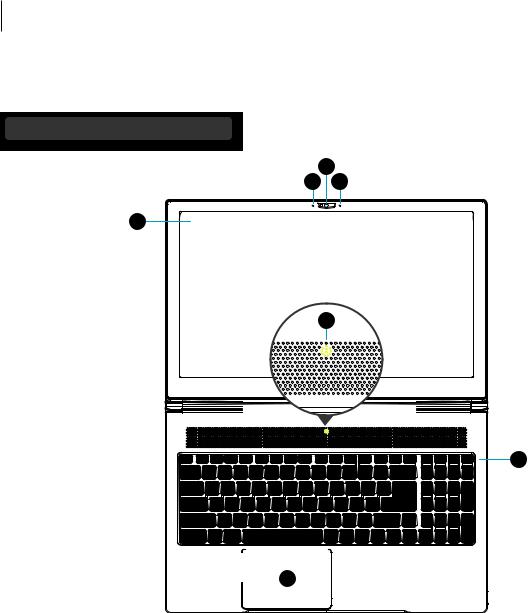
4 Overview
Exterior Components
1.4Exterior Components
Display and Base Components
3
2 2
1
6
4
5
No. |
Sign |
Component |
Description |
1 |
|
LCD display |
Built-in display for visual output. |
|
|
|
|
2 |
|
Microphone |
Built-in microphone for audio input. |
|
|
|
|
3 |
|
Webcam (optional) |
Built-in video camera for real-time video. |
|
|
|
|
4 |
|
Keyboard |
Built-in keyboard for control and input. |
|
|
|
|
5 |
|
Touchpad |
Built-in pointing device for control and input. |
|
|
|
|
|
|
|
• Glows yellow when the system is on. |
6 |
|
Power LED |
• Goes off when the system is off. |
|
|
|
• Glows red when the system is in Sleep mode. |
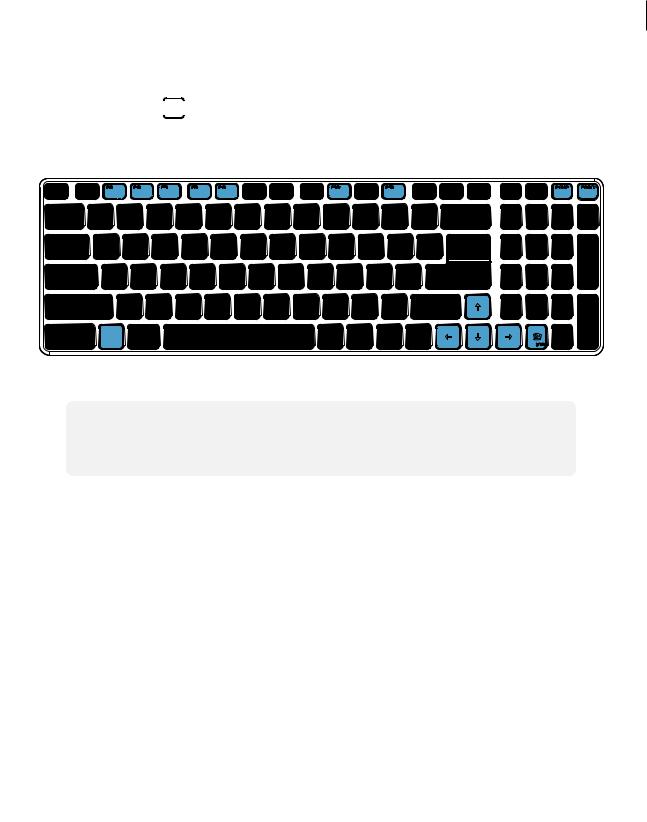
Overview 5
Exterior Components
Fn Key Combinations
With the combination of Fn  plus another specific key (with one printed blue symbol on it), you can quickly adjust hardware settings to suit your needs.
plus another specific key (with one printed blue symbol on it), you can quickly adjust hardware settings to suit your needs.
NOTE
• To use an Fn key combination, press and hold Fn, and then press another key.
Combination Description |
Combination Description |
Use to switch the use of displays.
Use to increase the brightness of the LCD display.
Use to enable / disable the touchpad. |
Use to decrease the brightness of |
|
the LCD display. |
||
|
Use to launch the defined application. |
Use to decrease the volume of the |
|
NOTE: This may not be applicable. |
built-in speakers. |
|
Use to enable / disable the ECO mode. |
Use to increase the volume of the |
|
ECO Mode: Screen Off mode |
built-in speakers. |
|
Use to enable / disable the Webcam. |
Use to mute / unmute the sound. |
|
Use to enable / disable the Airplane mode. |
Use to function as a Home key. |
|
Airplane Mode: disabled networks of all types |
||
|
||
Use to enter the System Sleep mode. |
Use to function as an End key. |
|
Press the Power button or any key to exit. |
||
|
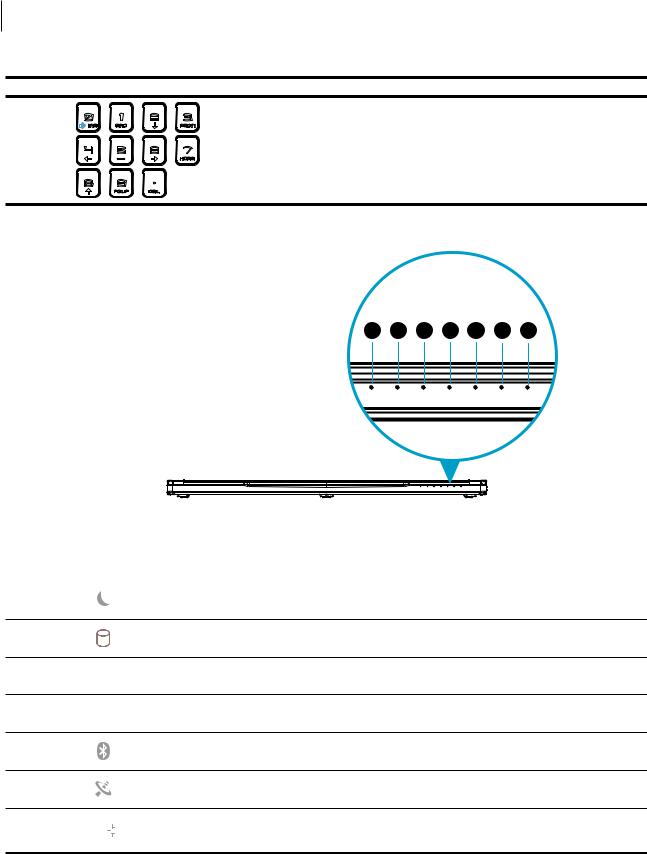
6 Overview
Exterior Components
Digits and Symbols in Num Lock Mode Description
Use to type in the desired digit or symbol.
NOTE: You must enable the Num Lock mode first.
7 8 9 10 11 12 13
No. |
Sign |
Component |
Description |
7 |
|
Sleep mode LED |
Glows orange when in Sleep mode. |
8
9
10
11
12
13
|
|
|
|
Storage LED |
Blinks blue when flash memory is being accessed. |
|
|
|
|
|
|
|
|
1 |
|
Num Lock LED |
Glows blue when Num Lock is enabled. |
|
|
|
|
|
|
|
|
A |
Caps Lock LED |
Glows blue when Caps Lock is enabled. |
|
|
|
|
|
Bluetooth LED |
Glows blue when Bluetooth is enabled. |
|
|
|
|
Wireless LED |
Glows blue when Airplane mode is enabled. |
|
|
|
|
Airplane mode: disabled networks of all types |
|
|
|
|
|
|
|
|
|
|
|
|
• Glows orange when the battery is being charged. |
|
|
|
|
Battery LED |
• Glows blue when the battery is fully charged. |
|
|
|
|
||
|
|
|
|
|
• Blinks orange when the battery power is low. |
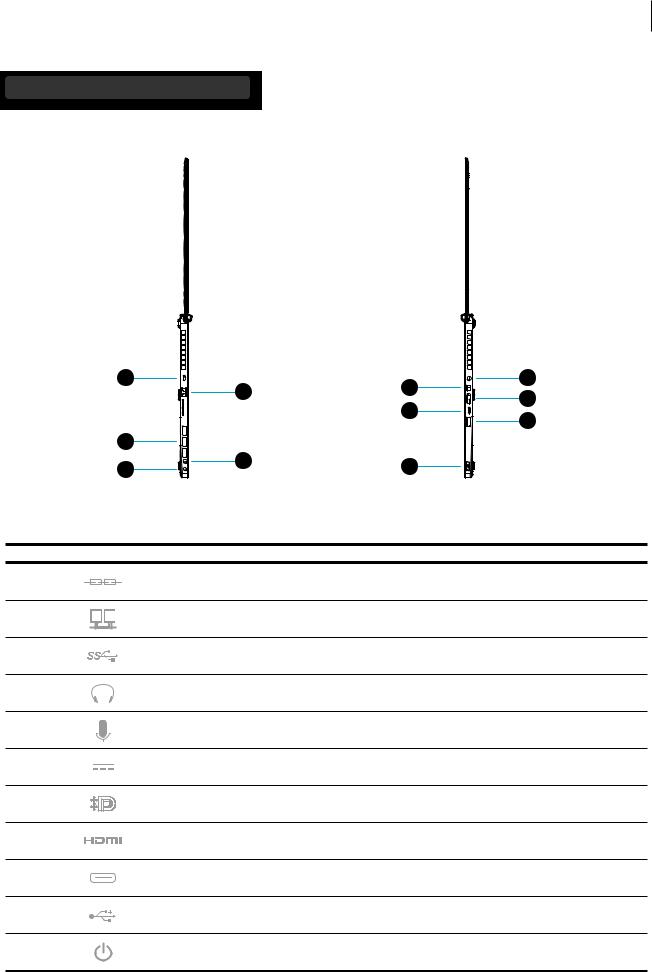
Overview 7
Exterior Components
Left and Right Side Components
14 |
15 |
20 |
19 |
|
21 |
||
|
|
22 |
|
|
|
23 |
|
|
|
|
|
16 |
|
|
|
18 |
17 |
24 |
|
|
|
No. |
Sign |
Component |
Description |
14 |
|
Kensington security slot |
Connects a Kensington cable to secure the mobile thin client. |
15 |
|
LAN port |
Connects to a network. |
16 |
|
USB port (USB 3.0) |
Connects to a USB device. |
17 |
|
Headphone port |
Connects to a set of headphones or a speaker system. |
18 |
|
Microphone port |
Connects to a microphone. |
19 |
|
DC IN |
Connects to an AC adapter. |
20 |
|
mini DisplayPort |
Connects to a monitor. |
21 |
|
HDMI port |
Connects to a high quality digital audiovisual device. |
22 |
|
USB Type-C |
Connects to a USB Type-C device. |
23 |
|
USB port (USB 2.0) |
Connects to a USB device. |
24 |
|
Power button |
• Press to power on your mt188L when the lid is opened. |
|
• Press to enter Sleep mode when your mt188L is on. |
||
|
|
|
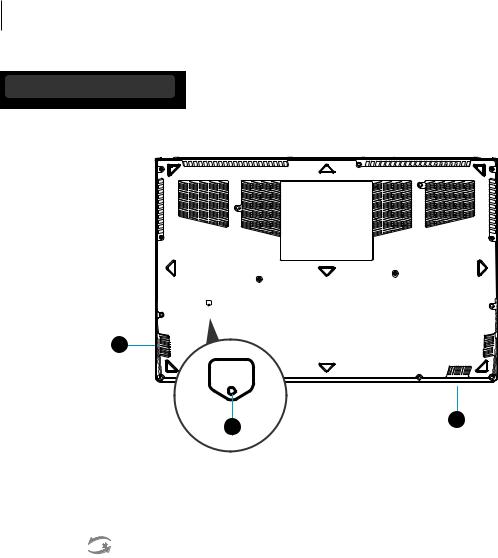
8 Overview
Exterior Components
Bottom Components
25
|
|
|
|
26 |
25 |
|
|
|
|
|
|
|
|
|
|
|
|
No. |
Sign |
Component |
Description |
||
25 |
|
|
|
Speaker |
Built-in speakers for audio output. |
|
|
|
|
|
|
26 |
|
|
|
Battery Off hole |
Used to press the button inside to enter the Battery Sleep mode. |
|
|
|
Please see “About the Battery Sleep Mode” on page 9 for details. |
||
|
|
|
|||
|
|
|
|
|
|
|
|
|
|
|
|

Overview 9
Before Getting Started
1.5Before Getting Started
About the Battery Sleep Mode
For first time use, you must connect your mt188L to a power outlet using the supplied AC adapter for the built-in battery to exit the Sleep mode.
To enter the Battery Sleep mode when needed, please do the following:
1.Shut down and unplug your mt188L.
2.Use the tip of an unfolded paper clip (or a similar object without a sharp tip) to gently press the button inside the Battery Off hole.
NOTE
• Please note that, to exit the Battery Sleep mode and power on your mt188L, you will need to plug it in first using the supplied AC adapter.

10 Overview

2
Getting Started
This chapter provides the basics of how to use your mt188L.
2.1 Learning the Basics |
|
Topic 1: Atrust Quick Connection |
14 |
Topic 2: Setting Up a Wireless Connection |
16 |
Topic 3: Configuring the Time Zone |
18 |
Topic 4: Accessing Desktops or Applications |
19 |
Topic 5: Using Built-in Applications |
33 |
Topic 6: Viewing and Managing the Use of Power |
35 |

Getting Started 13
Learning the Basics
2.1Learning the Basics
The following topics will guide you through the basics of using your mt188L:
Topic 1: Atrust Quick Connection
Topic 2: Setting Up a Wireless Connection
Topic 3: Configuring the Time Zone
Topic 4: Accessing Desktops or Applications
•Microsoft Remote Desktop Services (RDP sessions)
•Citrix Services (ICA sessions)
•VMware View or Horizon View Services (View sessions)
Topic 5: Using Built-in Applications
Topic 6: Viewing and Managing the Use of Power
NOTE
• In case that by default your mt188L is Auto Setup enabled, its user environment might be different from here and will vary with preset configurations. See section 3.2.9 and appendix A.4, and consult your IT administrator for details.
NOTE
• Three client modes are available for your mt188L:
No. |
Mode |
Description |
|
|
|
|
|
|
|
The client will start up directly with the desired RDP |
|
|
|
/ ICA / View / Web / 2X session and perform the |
|
|
|
configured action after exiting the session. |
|
1 |
Appliance |
Available actions include: |
|
|
|
||
|
|
• |
Re-launching a new session |
|
|
• |
Restarting the thin client |
|
|
• |
Turning off the thin client |
The client will start up directly with the desired RDP / ICA / View / Web / 2X session and perform the configured action after exiting the session.
Available actions include: (n/a to Web browser)
2 |
Autostart |
• |
Returning to the local desktop |
|
|
||
|
|
• |
Re-launching a new session |
|
|
• |
Restarting the thin client |
|
|
• |
Turning off the thin client |
|
|
|
|
3 |
Quick Connection |
The client will enter Atrust Quick Connection screen |
|
after system startup. |
|||
•In Quick Connection mode, you can access Microsoft Remote Desktop / Citrix / VMware View or Horizon View services quickly without much client configuration required. The main purpose of this chapter is to guide you through the use of your mt188L under the Quick Connection mode. The default of your mt188L is NOT the Quick Connection mode (after restart it will enter the local Linux desktop rather than Atrust Quick Connection screen), but you can enter Atrust Quick Connection screen through its shortcut on the local desktop or START menu.
•To understand other modes, configure advanced settings, and customize your mt188L, please refer to chapter 3 “Configuring Client Settings” on page 37.
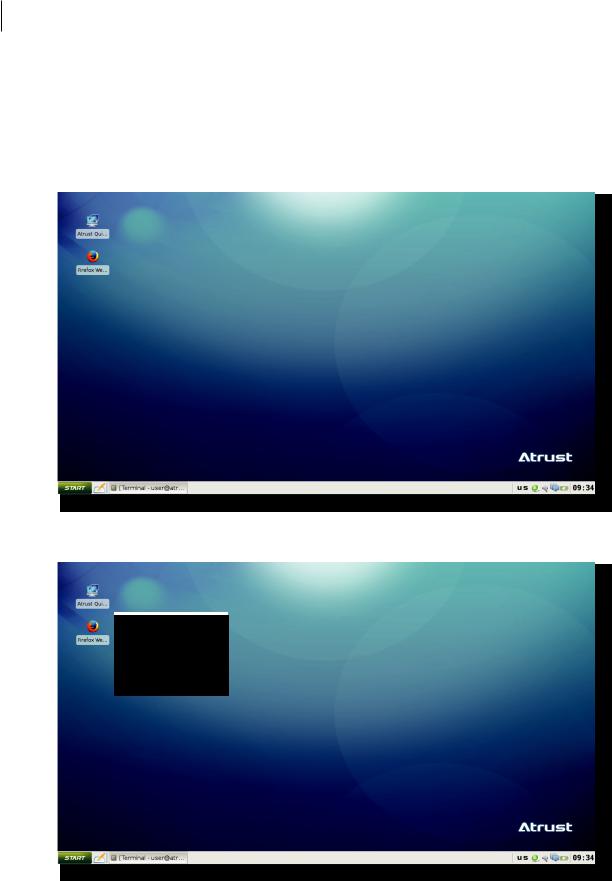
14 Getting Started
Learning the Basics
Topic 1: Atrust Quick Connection
To start using your mt188L, please do the following:
1. Press the Power button to turn on the client. Wait a moment for the system to enter the local Linux desktop.
Local Linux Desktop
2. Click Atrust Quick Connection  on the desktop to enter Atrust Quick Connection screen.
on the desktop to enter Atrust Quick Connection screen.
Atrust Quick Connection
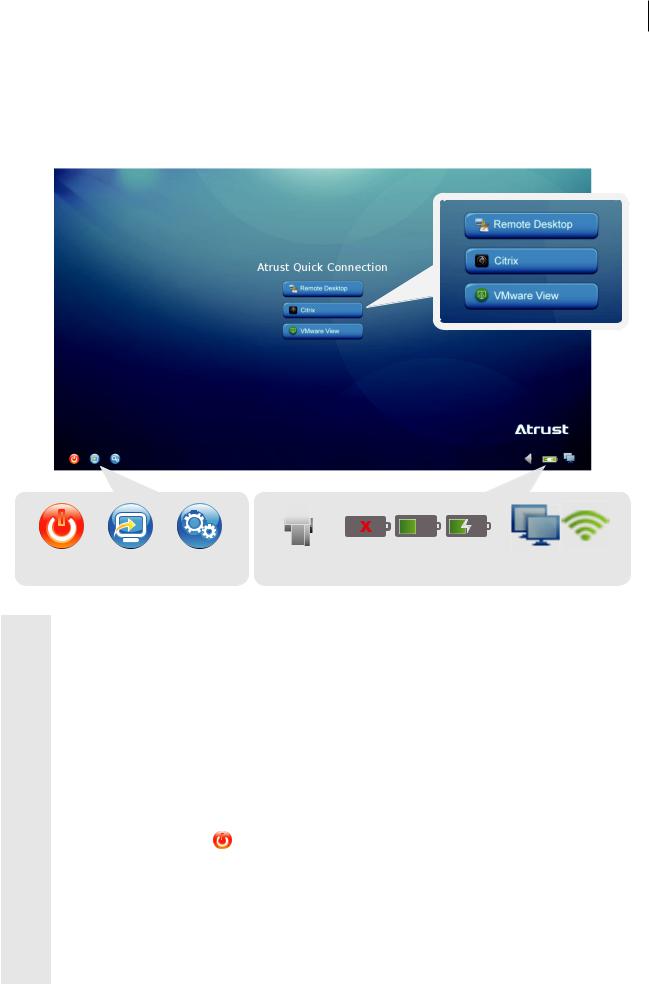
Getting Started 15
Learning the Basics
3.(a) Go to Topic 2 to set up a wireless connection if needed.
(b)Go to Topic 3 to set the time zone for the first time use.
(c)Go to Topic 4 for service access if the time zone had been set.
Atrust Quick Connection Screen
|
|
|
|
|
|
|
|
|
|
|
|
|
|
|
|
|
|
|
|
|
|
|
|
|
|
|
|
|
|
|
|
|
|
|
|
|
|
|
|
|
|
|
|
|
|
|
|
|
|
|
|
|
|
|
|
|
|
|
|
|
|
|
|
|
|
|
|
|
|
|
|
|
|
|
|
|
|
|
|
|
|
|
|
|
|
|
|
|
|
|
|
|
|
|
|
|
|
|
|
|
|
|
|
|
1 |
2 |
3 |
|
|
4 |
|
5 |
6 |
|
|
|
||
|
|
|
|
|
|
|
|
|
|
|
|
|
|
|
|
|
|
|
|
|
|
|
|
|
|
|
|
|
|
|
|
|
|
|
|
No. |
Icon |
|
Description |
|
|
|
|
|
||||||
|
|
|
|
|
|
|
|
|
|
|
|
|
|
|
||
1 |
Power Off |
|
Click to shut down, suspend, or restart the system. |
|
|
|
|
|||||||||
|
|
|
|
|
|
|
|
|
|
|
|
|
|
|
||
2 |
Local Desktop |
Click to return to the local Linux desktop. |
|
|
|
|
|
|||||||||
|
|
|
|
|
|
|
|
|
|
|
|
|
|
|
|
|
3 |
Setup |
|
Click to launch Atrust Client Setup. |
|
|
|
|
|
||||||||
|
|
|
|
|
|
|
|
|
|
|
|
|
|
|
|
|
4 |
Mixer |
|
Click to configure audio settings. |
|
|
|
|
|
||||||||
|
|
|
|
|
|
|
|
|
|
|
|
|
|
|
||
|
|
|
|
|
Indicates the power source (adapter, battery, or both) and status. |
|
|
|
|
|||||||
|
|
|
|
|
Click to launch Power Management for details. |
|
|
|
|
|||||||
|
|
|
|
|
NOTE: Power Management enables you to configure power-saving settings for your |
|||||||||||
|
|
|
|
|
|
mt188L. You can choose appropriate options to suit your needs. See “Topic 6: |
||||||||||
5 |
Power |
|
|
Viewing and Managing the Use of Power” on page 35 for details. |
||||||||||||
|
NOTE: When your mt188L enters System Sleep mode manually (Fn + F12 or |
|||||||||||||||
|
|
|
|
|
||||||||||||
|
|
|
|
|
|
|
|
> Suspend) or automatically (configured in Atrust Client Setup through |
||||||||
|
|
|
|
|
|
|
|
|||||||||
|
|
|
|
|
|
|
|
|||||||||
|
|
|
|
|
|
System > Power Management), it still requires a certain amount of power. |
||||||||||
|
|
|
|
|
|
You can use Shut down option instead to save the power to a greater degree. |
||||||||||
|
|
|
|
|
NOTE: When using only the battery as the power source, ensure that it has enough |
|||||||||||
|
|
|
|
|
|
power to prevent data loss. |
|
|
|
|
|
|||||
|
|
|
|
|
|
|
|
|
|
|
|
|
|
|
||
|
|
|
|
|
Indicates the network type (wired or wireless) and status. |
|
|
|
|
|||||||
6 |
Network |
|
Click to configure network settings. |
|
|
|
|
|
||||||||
|
NOTE: To set up a wireless connection, please see “Topic 2: Setting Up a Wireless |
|||||||||||||||
|
|
|
|
|
||||||||||||
|
|
|
|
|
|
Connection” on page 16. |
|
|
|
|
|
|||||
|
|
|
|
|
|
|
|
|
|
|
|
|
|
|
|
|
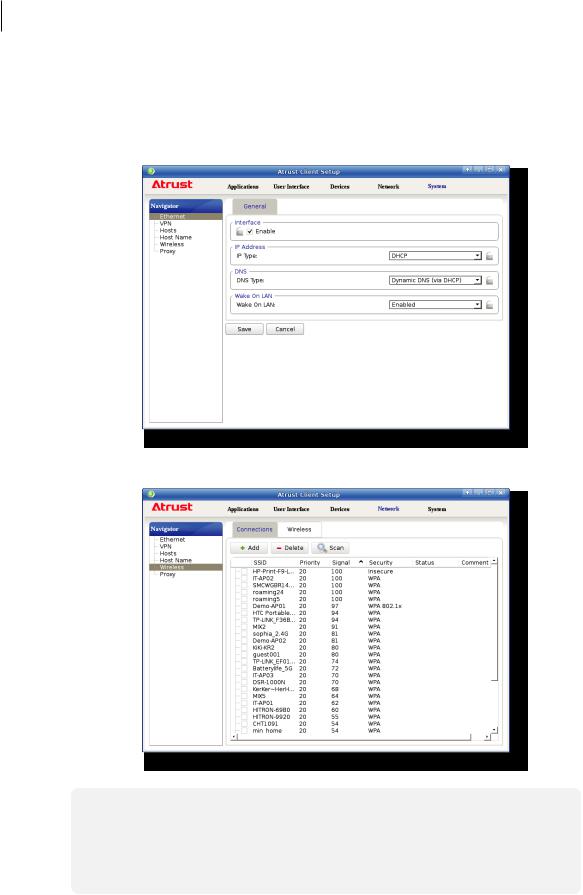
16 Getting Started
Learning the Basics
Topic 2: Setting Up a Wireless Connection
To set up a wireless connection, please do the following:
1. On Atrust Quick Connection screen, click the Network  icon. Atrust Client Setup is launched.
icon. Atrust Client Setup is launched.
2. Click Wireless. The Wireless Network list will be shown under the Connections sub-tab.
NOTE
• Your mt188L will perform network discovery once and specify all available wireless networks in the Wireless Network list under the Connections sub-tab. To refresh this
Wireless Network list, click |
on the top of the list. |
3.Click to check the desired wireless network. The Connect button  then appears on the top of the Wireless Network list.
then appears on the top of the Wireless Network list.
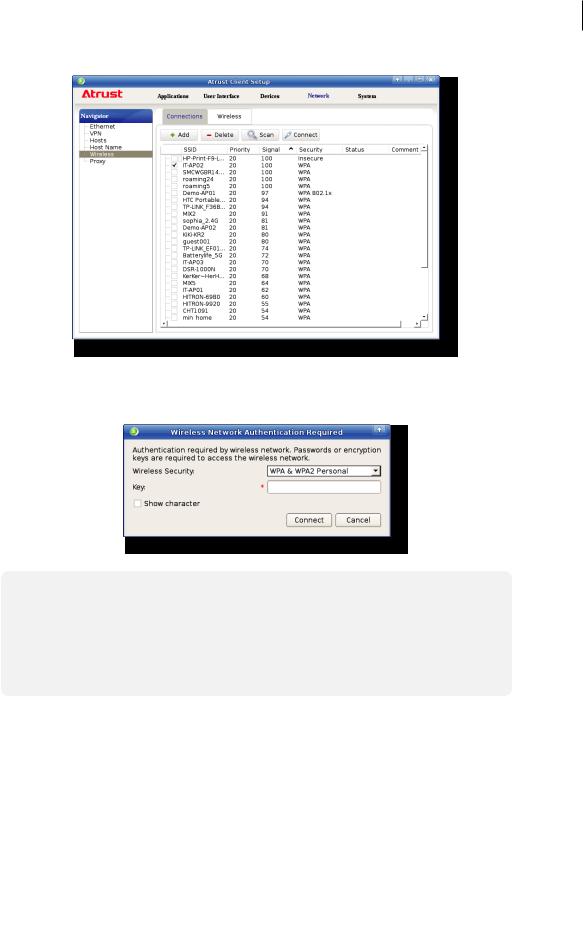
Getting Started 17
Learning the Basics
4.Click  to create a wireless network connection through the selected wireless network.
to create a wireless network connection through the selected wireless network.
5.A window appears prompting for confirmation or authentication.
NOTE
• If you ever accessed this wireless network before, the password will be automatically recorded for future access. In this case, you don’t need to provide the password again; you only need to confirm the establishment of a wireless connection.
•Consult your network administrator for required information on authentication.
6.Type in the required password, and then click Connect to continue. Or, click OK to confirm the establishment of a wireless connection.
7.Upon completion, the Status column of the wireless network will show connected.
8. Close Atrust Client Setup.
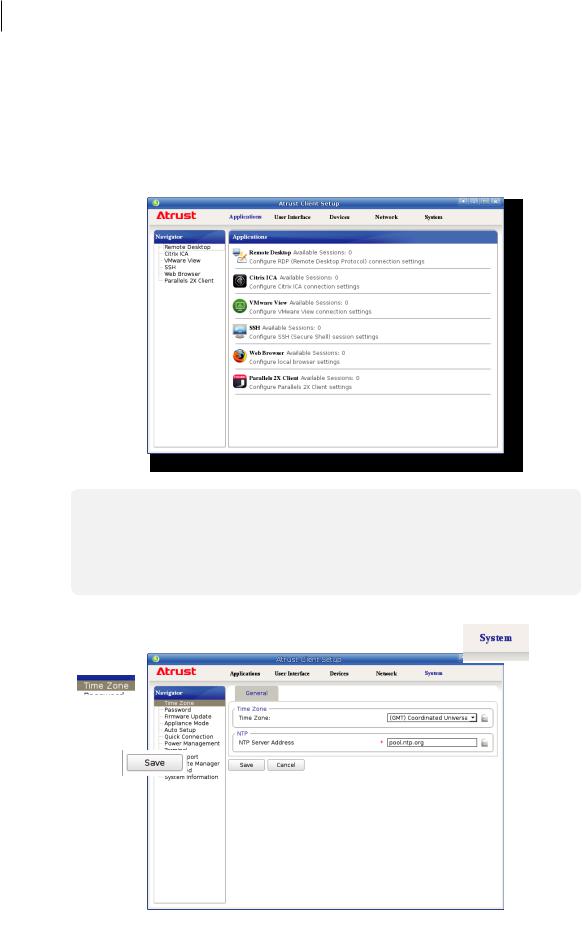
18 Getting Started
Learning the Basics
Topic 3: Configuring the Time Zone
To set the time zone for your mt188L, please do the following:
1. Click the Setup  icon to launch Atrust Client Setup.
icon to launch Atrust Client Setup.
Atrust Client Setup
Navigation Area
Click to select a setting item or entry.
Category Tabs
Click a tab to select a setting category.
NOTE
• For detailed instructions on how to configure client settings and customize your mt188L with Atrust Client Setup, please refer to chapter 3 “Configuring Client Settings” on page 37.
2. On Atrust Client Setup, click System > Time Zone.
Time Zone drop-down menu
3.Click the Time Zone drop-down menu to select the desired time zone.
4.Click Save to apply, and then close Atrust Client Setup.
